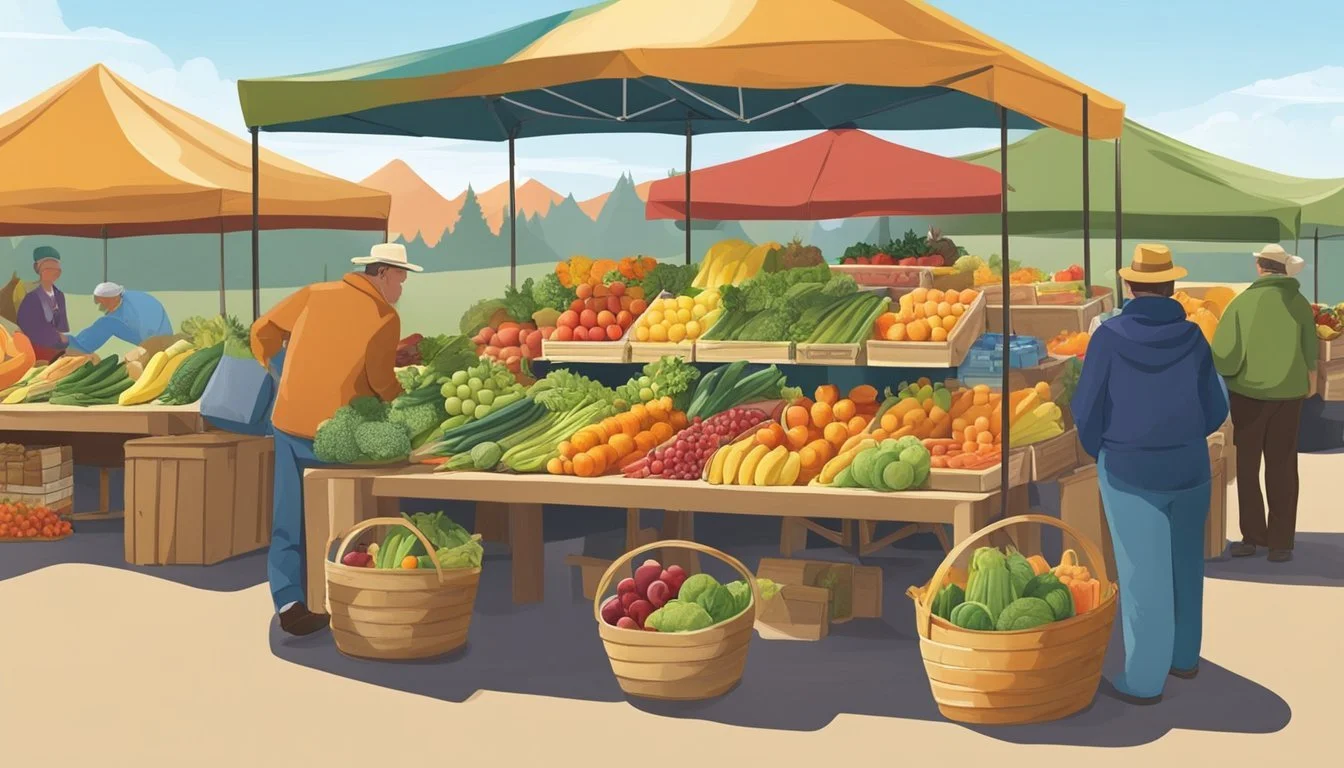Wyoming Seasonal Fruit & Vegetables in October
A Guide to Autumn Harvests
This Article is Part of our Wyoming Seasonal Fruit & Veg Calendar
October in Wyoming offers a bountiful harvest, a reflection of the state's agricultural abundance during this month. The cool climate provides optimal conditions for a variety of fruit (What wine goes well with fruit?) and vegetables to reach their peak ripeness. As the leaves turn and the temperatures drop, Wyoming's farms and gardens transition from the summer's offerings to a fall bounty that features both the tail end of summer produce and the heartier crops that thrive in cooler weather.
Wyomingites and visitors alike have the opportunity to enjoy the fresh, locally-grown produce that includes an array of root vegetables and late-season fruits. The state's harvest calendar highlights the availability of produce like apples (how long do apples last?), which come in numerous varieties and are a hallmark of fall's fruit selection. On the vegetable front, October is an excellent time for broccoli (how long does broccoli last?), a nutrient-packed vegetable that can be enjoyed raw or cooked, offering versatility in autumnal recipes.
While the weather in Wyoming can be unpredictable, October generally marks a time when crops such as blackberries conclude their season, offering the last sweet and less tart berries of the year. Meanwhile, vegetables like rutabagas come into their prime, offering a sweet root option for a host of hearty dishes that suit the cooling days. Wyoming's October harvest allows for a celebration of the season's flavors, with a focus on local, seasonal eating that supports the state's agricultural community.
Overview of Wyoming’s October Climate
In Wyoming, October is a transitional month where the climate shifts from the mild warmth of fall towards the colder air of the approaching winter.
Impact of Fall Weather on Produce
October's fall weather entails both dwindling daylight hours and a noticeable drop in temperatures, influencing local produce harvests. Daytime temperatures typically hover around 15°C (59°F), while nighttime can see lows around 2°C (35.6°F). These conditions result in a gradual cessation of growth for many plants, leading to the final harvests of the season. The climate during this month can determine the quality and quantity of seasonal fruits and vegetables available.
Seasonal Fruits Available in October
In October, Wyoming's fruit harvest offers a diverse range of fresh flavors. This period marks the peak season for many local fruits, making it an ideal time for consumers to enjoy them at their freshest and most flavorful.
Apples and Their Varieties
Wyoming in October becomes a hub for apple enthusiasts, as various apple varieties reach their peak ripeness. One can find Honeycrisp apples, cherished for their crisp texture and balanced sweetness, making them perfect for both eating fresh and baking into a heartwarming apple pie. Gala apples are also widely available, offering a milder flavor suitable for snacks and salads.
Pears: Choosing and Using
Pears accompany apples in the seasonal harvest. Their soft, buttery texture is especially sought after this month. Bartlett pears are known for their juicy sweetness, while Bosc pears provide a firmer texture suitable for cooking applications, such as in cobblers or roasted dishes (What wine goes well with roasted dishes?). When selecting pears, one should look for fruits that are firm to touch with a slight softness at the stem end.
Grapes and Late-Season Berries
Grape varieties, particularly the concord and seedless types, are also harvested in October. These grapes are excellent for fresh consumption, and their vibrant flavors translate well into grape jellies and juices. Late-season berries, like the blackberry, remain available. These berries have had the entire season to develop a rich, sweet flavor that's less tart, making them ideal for fresh eating or as additions to desserts.
Exotic Alternatives: Quince and Pomegranates
For those looking for something less traditional, October also sees the arrival of quince and pomegranates. Quince, with its floral aroma and firm flesh, requires cooking to be palatable but then transforms into a delicate addition to various dishes. Pomegranates, on the other hand, offer jewel-like seeds that burst with tangy-sweet juice, elevating both the flavor and appearance of salads and other preparations.
Seasonal Vegetables Harvested in October
October in Wyoming brings a rich bounty of hearty vegetables. Gardeners and farmers harvest a variety of root vegetables, leafy greens, and alliums that are particularly suited for warming autumn dishes.
Root Vegetables and Squash
Root Vegetables: October is prime time for harvesting a range of root vegetables. In Wyoming, gardeners pull up sweet potatoes and potatoes, which are perfect for roasting and mashing. Beets (how long do beets last?), carrots, parsnips, and rutabagas also reach peak ripeness, offering earthy flavors ideal for soups and stews.
Winter Squash: Varieties like pumpkins and winter squash come into their own. Their dense flesh can be transformed into comforting dishes, whether sweet or savory.
Vegetable Preparation Methods Sweet potatoes roasted, mashed Potatoes roasted, mashed Beets roasted, soups Carrots roasted, soups Pumpkins soups, pies Winter squash roasted, soups
Cruciferous Vegetables and Greens
Cruciferous and Leafy Vegetables: As the weather cools, cruciferous vegetables like broccoli, cauliflower, and brussels sprouts (how long do brussels sprouts last?)are in season. These are typically enjoyed roasted to bring out their nutty flavors. Leafy greens such as kale, cabbage, and spinach thrive in cooler temperatures and are versatile in a range of dishes from salads to sautéed sides.
Radicchio: Another fall favorite, radicchio adds a vibrant color and a bitter edge to salads, balancing the richer flavors of the season.
Alliums and Other Fall Staples
Alliums: The allium family, including onions and garlic, is harvested. These staples are integral to flavor profiles across countless recipes and especially enhance the taste of roasted vegetables and meat dishes.
Leeks: A milder relative of the onion, leeks are often used to add depth to soups and stews or can be the star in creamy leek dishes.
With the variety of vegetables October yields, Wyoming's kitchens are filled with the aromas of roasting and simmering, as chefs and home cooks alike utilize the season's produce to create warm, flavorful meals.
Flavor Enhancers and Additional Ingredients
Incorporating a variety of herbs, spices, legumes, and grains elevates the natural flavors of Wyoming's seasonal produce. These additional ingredients enhance the taste experience of autumn meals, from hearty stews to refreshing salads.
Herbs and Spices for Autumn Dishes
The cooler fall temperatures in Wyoming pair well with warm flavors. Cinnamon and ginger stand out as quintessential fall spices, offering spicy warmth to both sweet and savory dishes. For instance, adding a dash of cinnamon can complement the sweetness of roasted squash, while ginger brings a zesty note to carrot soups.
In addition to these spices, a range of herbs can be woven into autumn recipes to enhance basic ingredients like celery, lending complexity and depth. Sage, rosemary, and thyme are robust herbs that can withstand longer cooking times common in fall cooking, making them ideal for dishes featuring beans or peas.
Autumn Harvest Legumes and Grains
Legumes and grains serve as foundational elements for many seasonal meals. They not only provide rich textures and flavors but also contribute important nutrients to the diet. In October, consider the following to accompany the harvest:
Beans: Great in chilies and stews, beans absorb flavors from herbs and spices while adding a creamy texture.
Peas: Fresh or frozen, peas are a sweet counterpart to earthy fall vegetables and work well in salads and soups.
Corn: Whether grilled, roasted, or added to a vegetable medley, corn offers a touch of sweetness that balances the savory notes of fall dishes.
These grains and legumes can be further enriched with sauces and dressings featuring local honey for natural sweetness or a splash of savory soy or Worcestershire sauce (how long does worcestershire sauce last?). Integrating these components into cooking creates complex and memorable meals that celebrate the heartiness of Wyoming's fall bounty.
Nutritional Benefits of October Produce
October’s harvest in Wyoming offers a robust array of produce that is not only flavorful but also rich in nutritional benefits. Focusing on the vitamins and antioxidants these crops provide, consumers can enrich their diet effectively.
Vitamins and Antioxidants in Seasonal Produce
Pumpkins: As a staple of the season, pumpkins are a significant source of vitamins, particularly vitamin A, which supports immune function and skin health. They also contain fiber which aids digestion.
Vitamin A: Important for vision and immune function
Fiber: Enhances gut health
Apples: A popular fruit of October, apples are packed with antioxidants which protect the body from oxidative stress. Additionally, they’re a good source of vitamin C and fiber.
Antioxidants: Combat oxidative stress
Vitamin C: Essential for the growth and repair of tissues
Cranberries: These berries are known for their high antioxidant content, including vitamin C and fiber, while contributing to urinary tract health.
Vitamin C: Aids in iron absorption and immune defense
Fiber: Promotes satiety and blood sugar regulation
Leafy Greens: Harvested in October, greens like kale and spinach are high in vitamins A, C, and K, as well as iron and antioxidants.
Vitamin K: Crucial for blood clotting and bone health
Iron: Essential for blood production
Cruciferous Vegetables: Vegetables such as broccoli and Brussels sprouts, widely available in October, provide a variety of nutritional benefits including vitamins C and K, fiber, and compounds that may support detoxification processes.
Vitamins C and K: Support immune function and bone health
Fiber: Benefits digestion
Consuming a variety of these fruits and vegetables not only diversifies one's palate but also ensures a balanced intake of essential nutrients, contributing to overall well-being.
Preparing and Preserving October Produce
As the vibrant fall season in Wyoming brings a variety of fresh produce, residents have the opportunity to extend the life of their October harvest through preservation methods such as canning, pickling, and freezing. These techniques ensure that the flavors of autumn can be savored throughout the winter months.
Canning and Pickling for Winter
The canning process involves placing fruits and vegetables in glass jars and heating them to a temperature that eliminates microorganisms that cause food to spoil. Properly canned goods can last for up to a year when stored in a cool, dark place. Pickling, a form of canning, is particularly great for preserving root vegetables such as beets, which are abundant in October. To pickle, one should use a mixture of vinegar, water, and salt, along with desired spices, to create a brine in which the produce will be submerged.
Pickling Brine for Beets:
Vinegar: 2 cups
Water: 2 cups
Pickling Salt: 2 tablespoons
Favorite Spices: e.g., cloves (how long do cloves last?), cinnamon stick, mustard seeds (how long do mustard seeds last?)
Steps:
Clean and slice beets into preferred sizes.
Prepare jars by sterilizing them.
Boil together vinegar, water, pickling salt, and spices.
Pack beets into jars and cover with hot brine.
Seal jars and process in a water bath canner.
Freezing and Storage Tips
Freezing provides another effective means to preserve the bountiful autumn harvest later into the year. It is ideal for fruit such as apples, which can be peeled, sliced, and frozen on a baking sheet before being transferred to airtight containers or freezer bags. For vegetables like broccoli, blanching (briefly boiling and then plunging into ice water) before freezing preserves the texture and flavor.
Apples:
Peel and core the apples.
Slice and arrange on a baking sheet to freeze individually.
Transfer to airtight containers or bags once frozen.
When storing produce, one should keep fruits and vegetables in a cool, dry space with a consistent temperature. Certain crops from October, like pumpkins and squashes, have a natural longevity and can be kept whole in the right conditions for several months.
Storage Conditions:
Temperature: Between 50-55°F (10-13°C)
Humidity: Low
Location: Dark, dry, and well-ventilated space
By following these methods, one can enjoy Wyoming's October produce well beyond the season.
Seasonal Meal Ideas and Recipes
In October, Wyoming's bounty of seasonal produce inspires warm and comforting meals. These recipes make the most of the harvest, from hearty stews to freshly baked treats and vibrant salads.
Hearty Stews and Casseroles
Wyoming's fall harvest offers an abundance of root vegetables and squash, perfect for hearty stews. One can simmer chunks of butternut squash and parsnips in a robust beef or venison (What wine goes well with venison?) stew, enriched with locally grown herbs. For a vegetarian option, combining several types of squash in a casserole with layers of sage and Gruyère cheese brings out the sweetness of the vegetables and the savory flavors of the cheese.
Baked Goods Featuring Fall Flavors
Fall in Wyoming is not complete without the aroma of baked goods. Utilizing October's apples, one might bake a classic apple cobbler with a hint of cinnamon, or indulge in pumpkin cinnamon rolls for a twist on a breakfast favorite. These treats are not only delicious but also infuse the kitchen with the essence of fall.
Creative Salads and Side Dishes
While autumn is often associated with heavier fare, salads made with crisp October produce provide a refreshing contrast. A salad of roasted beets, arugula, and Walnuts, perhaps drizzled with a balsamic reduction, embodies the season's flavors. For side dishes, roasting a medley of October vegetables like carrots and brussels sprouts with a touch of honey and thyme can enhance a main dish, or they could top a seasonal pizza with kale, roasted squash, and goat cheese.
Local Agriculture and Farming Practices
In Wyoming, agriculture plays a pivotal role in the local economy, with a focus on both crop production and livestock. Farming practices vary across the state, typically driven by the climate, soil conditions, and elevation, all of which influence the crops that can be grown successfully.
During the month of October, farmers harvest an array of late-season vegetables and fruits. They adapt to the semi-arid climate by implementing innovative practices which include:
Crop Rotation: This sustainable practice helps maintain soil health and prevents disease build-up.
Irrigation: Essential in Wyoming's dry environment, it is carefully managed to optimize water use.
Windbreaks: These are used to reduce soil erosion caused by the state's strong winds.
Local producers often employ organic methods to cultivate crops, although conventional farming is also present. Here is a selection of the typical October harvest:
Fruits Vegetables Apples Pumpkins Pears Squashes Plums Leafy Greens Root Vegetables
Wyoming's agriculture sector generally supports the idea of local and sustainable production. Small-scale farmers and community-supported agriculture operations are prevalent, ensuring that consumers have access to fresh, locally-sourced produce.
The state's extension services contribute to the farming knowledge base, providing growers with resources and guides on best practices for vegetable and fruit cultivation, tailored to Wyoming's unique climate and soil conditions.
Finding and Supporting Local Wyoming Producers
In Wyoming, October's cool temperatures bring a harvest of autumnal produce. To support local producers, consumers can visit Wyoming's online farmers' markets. Eat Wyoming, for example, offers a VeggieBox subscription that includes a variety of local and regionally grown vegetables and seasonal fruits.
Local food directories, such as the Wyoming Table by the Wyoming Business Council, serve as a valuable resource for consumers seeking to connect with Wyoming-based ranchers, farmers, and other food suppliers. Consumers can use this directory to directly purchase from the source, promoting a more sustainable and tightly-knit community.
Farmers' markets across the state, including those organized by the Veggie Lady in Casper, offer opportunities for locals to purchase fresh, seasonal produce while engaging with their community. The University of Wyoming Extension has also created a directory, pointing consumers to local food producers, with listings including specialty crops and homemade goods.
Furthermore, visiting U-Pick farms can be a delightful way to source seasonal fruits such as apples, which are typically ripe for picking in October. Here's a quick guide to finding local producers:
Method Description Online Markets Subscribe to services like Eat Wyoming's VeggieBox. Directories Use tools like Wyoming Table to find local suppliers. Local Farmers Markets Visit nearby markets for fresh produce and goods. U-Pick Farms Harvest your own fruits at local U-Pick farms.
By championing local producers, consumers contribute to the state's economy and sustainability efforts, reinforcing a sense of community through the act of purchasing local produce.











